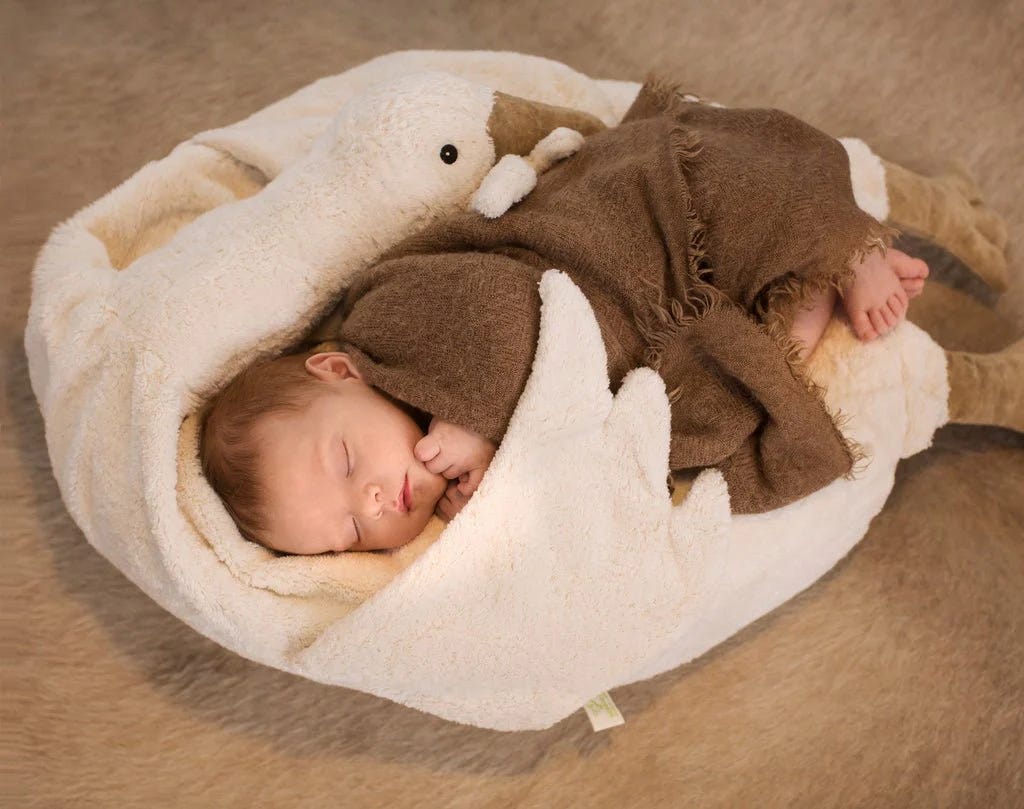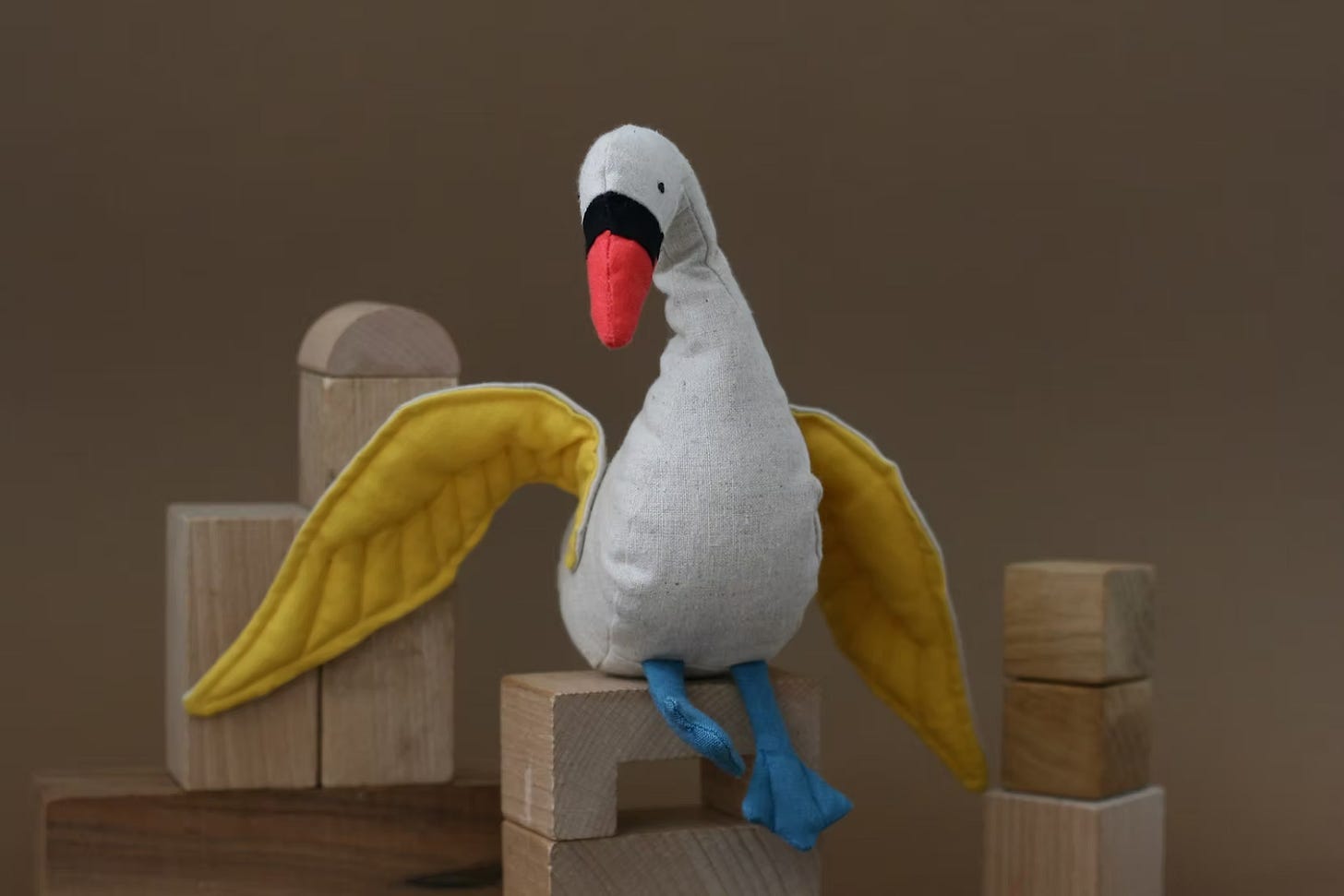From Gift Guide: The only safe all-natural soft toy brands that are also CHARMING!
Swan costumes.
I get a steady stream of questions about going plastic-free from my friends IRL. Even the dads are into it! So today I’m reposting antiplastic tips I contributed to the inimitable Substack Gift Guide.
This installment is on stuffed animals and dolls made with all-natural, organic materials. I contributed another piece on plastic-free foodware for kids that I’ll repost later.
Gift Guide is run by the renaissance woman Kaitlin Phillips, who—besides running the best Substack—is a writer, publicist, and friendship expert. I would also call her a leading American humorist and the premier pop-ethnographer of a certain sphere of New York (and now Connecticut!) life.
I think of Gift Guide as akin to the original, context-rich 1980s American Girl catalog, but centered on millennial women who respect material culture. Here is how Kaitlin describes the blog:
Now I write gift guides. It’s my hobby. I published my first gift guide on November 24th, 2020, for Spike (a German art magazine). I didn’t like being edited, so I started to publish them on Google docs. You can read an old Google doc gift guide here. Emily Sundberg interviewed me about it here. Air Mail published excerpts from my Gift Guides here & here. Past contributors to my Gift Guides include Lorde, Cecily Brown, Ina Garten, George Condo, Daphne Merkin, Merve Emre, Jamaica Kinkaid, Lauren Oyler, Francine Prose, Alison Roman, Susan Orlean, Emma Cline, Susan Miller, Olivia Nuzzi, Nell Zink, David Rimanelli, Jane Adams (the great American actress), Moira Hodgson, Richard Hell’s lover, etc. A typical recommendation from me: the best real estate agent in Litchfield County, plastic tick removers (stocking stuffers!), and the artwork of the elusive Contessa di Alicudi Schifanoja i.e. Roberto Longo. Not to be confused with Robert Longo.
That being said, I think Gift Guide, the publication, isn’t a series of trendy holiday-oriented gift guides. I’ll leave that to the magazines. It’s something a bit more discursive and fun. How better to put this? I’m not writing think pieces, I’m linking to things.
Gift Guide is paywalled, so you can check out some of Kaitlin’s writing through her links here. If you want to try it, I’ll give the first ten people who ask a free month. (It won’t be my first time giving this Substack as a gift!)
Gift Guide also runs book clubs both online and IRL. Without Gift Guide I wouldn’t have read Fanny Howe’s novels, which made excellent, mind-bending summer break counter programming. Join now to read Vita Sackville-West, who certainly deserves being considered properly after being used so often merely to spice up Virginia Woolf scholarship! (Start with the secret memoirs that Vita’s son later published with annotations.)
***
From Gift Guide: The only safe all-natural soft toy brands that are also CHARMING!
Swan costumes.
Sophie Raseman is my favorite “parenting” Substacker, and a genius-woman who has worn many hats. (She “spent seven years in the U.S. Treasury Department under Obama and served on the advisory board of the U.S. Consumer Financial Protection Bureau.”) Here at Gift Guide, she is our anti-plastic correspondent. You may remember her extremely popular guide to non-toxic tableware.
I’ve asked her to write us a Gift Guide to Safe Toys. There’s nothing like giving child a stuffed giraffe or owl or octopus—but have you ever wondered if it was stuffed with plastic?? I’m going to be honest: No. I have not. I don’t think about things like that. But this is why it’s so much fun being friends with Sophie. (As a general aside, my favorite gift for children who can speak are finger puppets. It’s so fun to “put on a play.” I have no idea if these have plastic in them and I’m afraid to read the fine print. She recommends some hand puppets below. Best to buy those.)
There are domains where giving up plastic is a sacrifice. Soft toys should not be one of them. Here are some toymakers trying to help out parents on an antiplastic program.
First, a note: Some brands market their natural outer materials but fill the toys with synthetics. Unless a brand tells me exactly what their filling is on the website, I assume it’s plastic. Also: Cost isn’t a good indicator of natural materials for toys, as it is with say, sheets. (Sort of like how brands will flog a $500 girl’s “occasion” dress that’s 100% polyester.) I can only guess that when Pepa says their $315 (lovely) alpaca sheep stuffie is filled with “part-pellet,” they mean plastic?
Some examples of brands whose soft toys are made of plastic or filled with plastic: Jellycat, Maileg, Blabla, Steiff, Hansa. We have things from these brands we won’t be giving up for sentimental reasons, but I wish they’d move to fully organic, natural fibers. Maileg I will continue to buy for things the little ones won’t sleep with (the mouse dollhouse line).
My favorite all-natural soft toys brand at the moment is Senger, founded forty years ago by the German couple Volker and Sabine Senger. Everything is sourced, hand-woven, and tailored in Germany or other European countries. Senger’s cuddly and floppy lines and hand puppets stand out.
Before the Sengers started the toy business, Volker Senger published a comic magazine and Sabine Senger sold children’s books. Perhaps that explains why the copy on their website is so memorable:
Not only on the outside but also on the inside, [Volker Senger’s] animals are completely “green.” The floppy and cuddly toys, for example, which nestle softly into the hands of older children, have their round bellies stuffed with sheep’s wool. “We buy it from roaming shepherds whose flocks graze on the Eifel meadows and keep the Rhine dikes trimmed as neatly as a golf course.” The pink plush pig, for example, lazily sprawled on its belly, has its tummy padded with rustling spelt chaff. Its little brother, on the other hand, has a belly full of cherry stones. Both can be warmed up and placed on children’s tummies for comfort.
A belly full of cherry stones! I had given up hope that warming-pad toys could be anything but toxic; I shouldn’t have counted out German forest-lovers who inherited a small scale textile workshop.
I appreciate in particular how Senger obsesses over the weight and drape of the toys. How disappointing when a stuffie refuses to melt into one’s embrace. Among the most huggable friends from Senger is the giant white goose (organic cotton with lambswool fill). It comes in a large and small size to play mama and baby.

Senger also makes a goose-shaped beanbag chair in soft organic cotton, filled with wool and spelt. It’s $349. Not so far outside the range of “luxury” baby loungers that are simply sacks of plastic.

One wonders how much longer the Senger brand will be around with the current standards. The Sengers said publicly that they are retired but still hands-on. The brand is now owned by Toynamics, whose other brands mostly use plastic. I’d say buy the legacy Senger pieces while the founders are still involved.
I found my other favorite natural toys when searching for a nontoxic stuffed swan for a Björk swan dress costume. Swans are not as popular as they should be in the stuffie world. (Here’s a child’s swan dress costume on Etsy if you’re interested.) The Dutch brand, Kaplum, is run by Anna van Gerve and Alper Demir, who are designers and parents.

Incidentally, if you love swans for dressing up toddlers, as I do, Wauw Capow (FKA Bang Bang Copenhagen) is a Danish children’s clothing line with a thing for these elegant birds. The brand isn’t non-plastic, but I have made exceptions for them over the years after this swan harness two-piece whispered to me in Icelandic. Incidentally, the Marjan Pejoski Fall 2001 ready-to-wear collection from which Björk selected her swan dress was inspired by carousel animals.
For the classic baby-doll-without-plastic, we can head back over to Germany, the birthplace of the Waldorf school. (It was for the children of cigarette factory workers.) Bella Freud recently complained to The New Yorker about rigid Waldorf rules—it sounds like she’s joking but they really do prefer no corners! Still, we do have Waldorf militancy to thank for keeping the market alive for dolls in all-natural materials. Thus the company Nanchen has been able to keep its handmade, hand-painted doll wholesale business alive and independent in Germany since 1983. Nanchen was also started by a couple, though for over a decade they have been owned by two women who describe themselves as school friends, designers, and moms.
Nanchen doesn’t sell direct. In the U.S., I’d recommend buying Nanchen through The Wooden Wagon, because the site was founded by an obsessive stay-at-home-dad with excellent taste in toys. (Here are the other online retailers Nanchen works with.) I wrote on my Substack American Childhood about beautiful wooden math toys from The Wooden Wagon in case you’re interested. Something to know about Waldorf dolls is their minimalist, neutral faces are a part of the Waldorf attempt to give children more scope the imagination, which may help you if you find them overly precious at first glance.

You can browse Nanchen’s catalog to find what you like and then Google to find which retailer shipping to you carries that item. For older kids I recommend the dress-up dolls with mohair-yarn “wigs.” (Consider this flame-haired maiden for your Anne Shirley doll.) Nanchen offers a wide variety of outfits to give as future gifts, including gear to protect your new doll-grandchild from the inevitable North German “coastal wind.” For newborn gifts, I recommend this tiny charmer who can be tucked into his own music-box bed. It plays Mozart, natürlich.
Don’t forget Nanchen also offers a doll doctor service!


